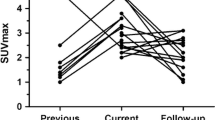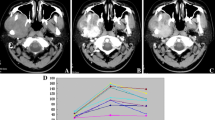Abstract
Solitary fibrous tumor (SFT) is a rare tumor of mesenchymal origin that most commonly involves the pleura but can be found anywhere in the body. SFT can range from indolent benign tumors to aggressive malignant tumors, and pre-operative diagnosis is based mainly on imaging. In this case report, we describe an extremely rare case of SFT of left maxilla on F-18 FDG PET-CT and Ga-68 DOTANOC PET-CT. Very few cases of PET-CT findings in SFT are reported in literature; and to our knowledge, none involving the maxilla. By highlighting the findings on F-18 FDG and GA-68 DOTANOC PET-CT, we aim to further add on to the role of both the tracers in the diagnosis and management of this tumor group.


Similar content being viewed by others
Data Availability
Contact the corresponding author for data requests.
References
Davanzo B, Emerson RE, Lisy M, Koniaris LG, Kays JK. Solitary fibrous tumor. Transl Gastroenterol Hepatol. 2018;3:94.
Chick JFB, Chauhan NR, Madan R. Solitary fibrous tumors of the thorax: nomenclature, epidemiology, radiologic and pathologic findings, differential diagnoses, and management. Am J Roentgenol. 2013;200:W238–48.
Doyle LA, Vivero M, Fletcher CD, Mertens F, Hornick JL. Nuclear expression of STAT6 distinguishes solitary fibrous tumor from histologic mimics. Mod Pathol. 2014;27:390–5.
Tariq MU, Din NU, Abdul-Ghafar J, Park YK. The many faces of solitary fibrous tumor; diversity of histological features, differential diagnosis and role of molecular studies and surrogate markers in avoiding misdiagnosis and predicting the behavior. Diagn Pathol. 2021;16:32.
Bruzzone A, Varaldo M, Ferrarazzo C, Tunesi G, Mencoboni M. Solitary fibrous tumor. Rare Tumors. 2010;2:e64.
Lococo F, Rufini V, Filice A, Paci M, Rindi G. 68Ga-DOTATOC PET/CT in pleural solitary fibrous tumors. Clin Nucl Med. 2021;46:e336–8.
Shinya T, Masaoka Y, Sando M, Tanabe S, Okamoto S, Ihara H, et al. Imaging an intrapulmonary solitary fibrous tumor with CT and F-18 FDG PET/CT. Radiol Case Rep. 2019;14:755–8.
Wang R, Liu Q, Sui H, Zhang M, Zhu Z, Cui R. 68Ga-FAPI outperforms 18F-FDG PET/CT in identifying solitary fibrous tumor. Eur J Nucl Med Mol Imaging. 2021;48:2055–6.
Liu X, Zhu W, Zhou X, Yao H, Su J, Ouyang X, et al. 18F-FDG PET/CT imaging findings of multiple solitary fibrous tumor: a case report. Medicine (Baltimore). 2019;98:e16743.
Ginat DT, Bokhari A, Bhatt S, Dogra V. Imaging features of solitary fibrous tumors. Am J Roentgenol. 2011;196:487–95.
de Bernardi A, Dufresne A, Mishellany F, Blay JY, Ray-Coquard I, Brahmi M. Novel therapeutic options for solitary fibrous tumor: antiangiogenic therapy and beyond. Cancers. 2022;14:1064.
Author information
Authors and Affiliations
Contributions
The study was designed by SAS. First draft of the manuscript was written by SP. Histopathology and immunohistochemistry images and their descriptions were provided by AB. The draft of the manuscript was reviewed by SAS and SR. All authors read and approved the final manuscript.
Corresponding author
Ethics declarations
Competing Interests
Sneha Prakash, Shamim Ahmed Shamim, Sameer Rastogi, and Adarsh Barwad declare that they have no conflict of interest.
Ethics Approval
The study was approved by the institutional review board of All India Institute of Medical Sciences. Informed consent was obtained from the participant in the study. All procedures performed in the study were in accordance with the Helsinki declaration as revised in 2013 and its later amendments.
Consent to Participate
The patient has consented to the submission of the case report to the journal.
Consent for Publication
The patient has consented to the submission of the case report to the journal.
Additional information
Publisher's Note
Springer Nature remains neutral with regard to jurisdictional claims in published maps and institutional affiliations.
Rights and permissions
Springer Nature or its licensor holds exclusive rights to this article under a publishing agreement with the author(s) or other rightsholder(s); author self-archiving of the accepted manuscript version of this article is solely governed by the terms of such publishing agreement and applicable law.
About this article
Cite this article
Prakash, S., Shamim, S.A., Rastogi, S. et al. A Rare Case of Solitary Fibrous Tumor of Maxilla: Findings on F-18 FDG and Ga-68 DOTANOC PET-CT. Nucl Med Mol Imaging 57, 34–37 (2023). https://doi.org/10.1007/s13139-022-00768-0
Received:
Revised:
Accepted:
Published:
Issue Date:
DOI: https://doi.org/10.1007/s13139-022-00768-0




